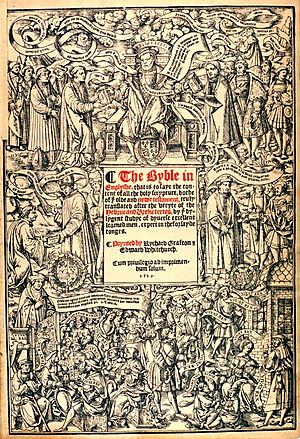Edward Whitchurch facts for kids
Edward Whitchurch was a famous printer and publisher in London during the 1500s. He played a big part in sharing new ideas and religious texts, especially those from the Protestant Reformation. He is best known for helping to print the very first complete Bible in English. Whitchurch lived until 1561.
Contents
Edward Whitchurch: A Printer's Story
Edward Whitchurch worked closely with another printer named Richard Grafton. Together, they achieved something very important in 1539. They published the first complete version of the Great Bible in English. This was a huge step because it meant more people could read the Bible in their own language.
Other Important Books
Besides the Great Bible, Edward Whitchurch published many other significant works. In 1547, he published A Treatise of Morall Phylosophie, contayning the Sayinges of the Wyse. This book was written by William Baldwin. Another important publication was the Paraphrases of Erasmus in 1548. These books helped spread knowledge and new ways of thinking.
Facing Challenges and New Opportunities
Life as a printer in those times could be challenging. After a powerful leader named Thomas Cromwell was removed from power, Whitchurch and Grafton faced trouble. They were sent to prison on April 8, 1543, but luckily, they were released just a few weeks later on May 3.
Despite these difficulties, they continued their work. On January 28, 1543-4, Whitchurch and Grafton received a special permission. This permission meant they were the only ones allowed to print church service books. Later, on May 28, 1546, they also gained the exclusive right to print primers. Primers were small textbooks used for teaching basic reading and prayers in Latin and English. By 1549, Whitchurch had five assistants helping him with his printing business.
A New Home and Leaving England
During the reign of King Henry VIII, many monasteries were closed down. This was part of a big change called the Dissolution of the Monasteries. The land and buildings of Merton Abbey were sold off. Edward Whitchurch and Lionel Dutchet bought this estate.
However, when Queen Mary came to the throne, things changed again. Queen Mary was a Catholic, and many Protestants, like Whitchurch, felt unsafe. So, Edward Whitchurch left England, possibly going to Germany. While he was away, in 1556, he married Margaret. She was the widow of Archbishop Cranmer, a very important leader of the English Reformation. The Merton Abbey site then became owned by the Garth family.
See also
- Yny lhyvyr hwnn


